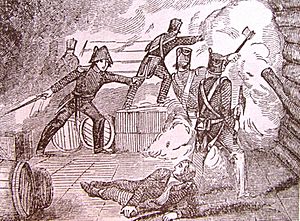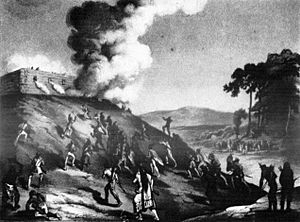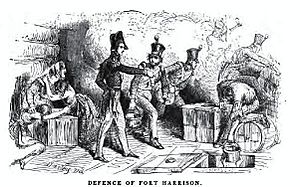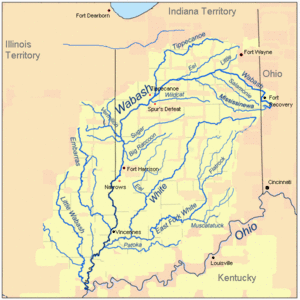Fort Harrison, Indiana facts for kids
Fort Harrison was a strong fort built during the War of 1812. It was constructed in October 1811 by soldiers led by General William Henry Harrison. The fort was located on high ground overlooking the Wabash River, in what is now Terre Haute, Indiana. It served as a gathering point for Harrison's army before the Battle of Tippecanoe a month later.
Fort Harrison became famous for a major battle in the War of 1812. This was the Siege of Fort Harrison in September 1812. It was the first important victory for the United States in that war. The fort was no longer needed and was left empty in 1818 as people moved further west.
Quick facts for kids Siege of Fort Harrison |
|||||||
|---|---|---|---|---|---|---|---|
| Part of the War of 1812 | |||||||
 Captain Zachary Taylor defending Fort Harrison in the War of 1812 |
|||||||
|
|||||||
| Belligerents | |||||||
| Native Americans Miami Potawatomi Kickapoo Winnebago |
|||||||
| Commanders and leaders | |||||||
|
Joseph Lenar Stone Eater |
Zachary Taylor | ||||||
| Strength | |||||||
| 600 | 20 healthy, 30 sick | ||||||
| Casualties and losses | |||||||
| Unknown – believed to be several killed or wounded |
- 2 killed before battle (civilians) |
||||||
Contents
Why Was Fort Harrison Built?
In 1811, General William Henry Harrison led his army north. They were marching from Vincennes to meet Native American groups at the Battle of Tippecanoe. Along the way, the army stopped in Terre Haute, Indiana. They built a fort on high ground overlooking the Wabash River. Harrison had wanted a fort in this important spot for a long time.
The fort helped protect the army's supply routes. It also guarded the capital of the Indiana Territory, which was Vincennes, located downstream. The fort was built in what is now Vigo County, Indiana. It was only two miles from the Wea village of Weauteno.
This area was once called Camp Bataille des Illinois. It was said to be the site of a historic battle involving the Illinois Confederation. Major Joseph Hamilton Daveiss suggested naming the fort Fort Harrison to honor General Harrison. The fort was finished on October 28, 1811. It had a strong wooden fence, called a stockade, that was about 150 feet (46 meters) long.
After the fort was built, General Harrison left a small group of soldiers there. Colonel James Miller was in charge. Harrison then led his main army to the Tippecanoe battleground. There, they faced an army led by the Shawnee prophet, Tenskwatawa.
When Harrison's army returned, he put Captain Josiah Snelling in charge of Fort Harrison. This was a reward for Snelling's bravery at Tippecanoe. Snelling commanded the fort from November 1811 until May 1812. During that winter, the fort was shaken by the 1811–12 New Madrid earthquakes.
After the War of 1812 began, Captain Zachary Taylor was ordered to take command of Fort Harrison. Taylor later became a President of the United States. The U.S. had lost some early battles against the British, Canadians, and Native Americans. These losses encouraged other Native American tribes to attack American outposts like Fort Harrison.
The Siege of Fort Harrison
The Siege of Fort Harrison was a battle that took place from September 4 to 12, 1812. A small group of U.S. soldiers inside the fort fought against a much larger force of Native Americans. The battle happened near what is now Terre Haute, Indiana. It was the first land victory for the United States during the War of 1812.
Warning and Preparation
On September 3, 1812, some Miami arrived at the fort. They warned Captain Taylor that a large group of Native Americans would soon attack. That evening, shots were heard outside the fort. Taylor was careful about sending out scouts. He only had 50 men in his fort, and many were sick. Only about 15 soldiers were healthy enough to fight.
The next morning, a group was sent out. They found the bodies of two white settlers, the Doyle brothers. The brothers were buried, and the group returned to Fort Harrison. Captain Taylor prepared for the attack with his 15 healthy soldiers and about 5 healthy settlers. Each of the 20 men was given sixteen rounds of ammunition.
The Attack Begins
On September 4, a force of 600 warriors approached Fort Harrison. These warriors were from the Potawatomi, Wea, Shawnee, Kickapoo, and Winnebago tribes. A group of 40 men, led by Kickapoo Chief Namahtoha, came forward with a white flag. They asked to talk with Taylor the next morning. Taylor agreed, and the Native American force went back to their camp for the night.
That night, a warrior secretly set fire to a blockhouse at the fort. When the guards shot at the arsonist, the 600-strong war party attacked the west side of the fort. Taylor ordered the fort's doctor and a few defenders to fight the fire. The blockhouse was connected to the barracks and stored whiskey, which quickly caught fire. The fire grew out of control.
Taylor later said that the situation looked hopeless. Two of his healthy men even ran away from the fort. Taylor shouted, "Taylor never surrenders!" He quickly organized a bucket brigade to fight the fire. They worked to stop it from destroying the fort's wooden walls. One brave woman, Julia Lambert, even climbed down into the fort's well to fill buckets faster.
Fighting and Repairing
The fire actually helped in one way: it lit up the night, showing where the attackers were. The fire left a 20-foot (6-meter) wide hole in the outer wall. The soldiers quickly sealed this gap with a 5-foot (1.5-meter) high temporary wall. The few remaining soldiers fired back at the Native Americans fiercely. They managed to hold off the attack.
All the sick soldiers were given weapons to help defend the fort. The healthy men worked hard to repair the hole in the walls. By daybreak on September 5, the fort was repaired. The Native American force moved back just out of gun range. They butchered farm animals they found nearby, in plain sight of the fort. Meanwhile, the soldiers and settlers inside the fort had lost most of their food in the fire. They only had a few bushels of corn and faced starvation.
Help Arrives
News of the siege reached Vincennes. Colonel William Russell was there with his soldiers. His companies joined with local militia and the 7th Infantry Regiment. Over 1000 men marched from Vincennes to help Fort Harrison. They arrived on September 12, and the Native American force left.
However, the next day, a supply train following Colonel Russell was attacked. This happened in an area called the Attack at the Narrows. This area is in modern Sullivan County, Indiana.
Attacks on Supply Wagons
A group of thirteen soldiers, led by Lieutenant Fairbanks, was escorting a supply wagon. It was loaded with flour and meat for the fort. On September 13, 1812, a Potawatomi war party ambushed the wagon. This happened at The Narrows, an area with many ravines. When the attack started, the horses pulling the wagon panicked and ran away with it. Only two men, the wagon driver John Black and Private Edward Perdue, escaped back to Fort Knox alive. Perdue was badly wounded. The Potawatomi chased the runaway supply wagon, so the two survivors were lucky. The U.S. lost eleven soldiers and all the supplies.
Two days later, a second group of two supply wagons and fifteen soldiers, led by Lieutenant Richardson, set out from Vincennes. They followed the same trail, not knowing what had happened to the first wagon. When the Potawatomi learned about this second supply train, they set up the same ambush. On September 15, after the first attack, Richardson realized his group was outnumbered. He ordered a retreat. The wagons were left behind to be taken by the attackers, which likely saved the lives of the retreating soldiers. Even so, seven men were killed, and another was badly wounded.
A few days later, a group led by Major McGary found the bodies. They went to Fort Harrison to tell Colonel Russell about the attacks. More importantly for the starving survivors at Fort Harrison, they reported the missing supply wagons.
After the Battle

The Battle of Fort Harrison is seen as the first land victory for the United States during the War of 1812. On the same day, General Harrison's forces helped Fort Wayne. This removed the last major Native American threat to Indiana Territory for the rest of the war.
To get back at the attackers of Fort Harrison and the Pigeon Roost Massacre, Colonel Russell continued into Illinois. He led an expedition against the Kickapoo near Peoria Lake.
For his brave actions at Fort Harrison, Zachary Taylor was promoted to major.
The fort was rebuilt in 1815 or 1816. It had a strong blockhouse at each corner. It was finally abandoned in 1818 after peace came to Indiana Territory.
Since both William Henry Harrison and Zachary Taylor commanded Fort Harrison, historians later called it "The Fort of Two Presidents."
In 1970, the fort's cemetery was found about 200 yards south of where the fort was thought to be.
Images for kids









